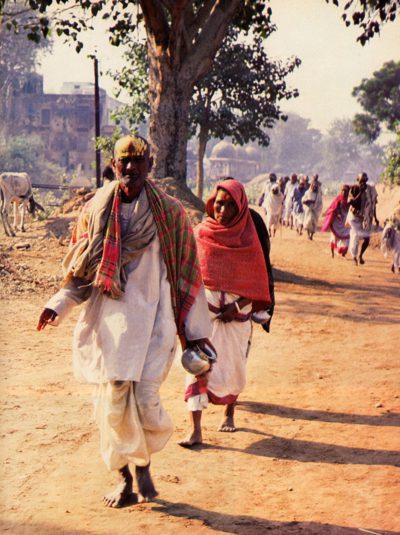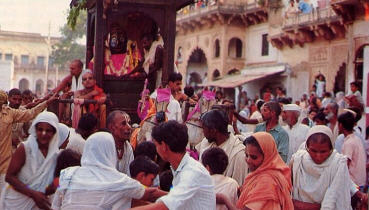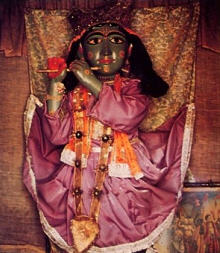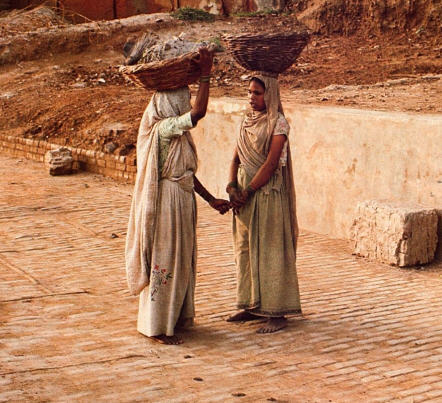Pilgrims circumambulating India's holiest city come to the end of the much-traveled thoroughfare of repeated birth and death.

Nestled ninety miles southeast of Delhi near a curve of the winding Yamuna River, Vrndavana is for Hindus what Jerusalem is for Jews and Mecca is for Mohammedans. En masse the pilgrims come especially on the holy days by train, bus, ricksha, taxi, horse-drawn tanga, and even on foot. Carrying their children and luggage, looking wide-eyed and innocent, they come to see the holy tirtha, to touch the sacred earth, to beg the blessings of the Deities in the temple, to hear from the pious residents, to chant the holy names of the Lord, and to circumambulate on bare feet the sacred land of Vrndavana.
It was in Vrndavana that the Supreme Lord, Sri Krsna, passed the first fifteen years of His earthly pastimes fifty centuries ago. There Lord Krsna pleased His parents and neighbors by acting like the perfect child, delighted His young boyfriends by playing with them as equals, killed His mortal enemies by His omnipotence, and charmed the cowherd girls by His all-attractive presence. Through these Vrndavana pastimes, He attracts all of us to rejoin Him in the spiritual kingdom, far beyond our mundane sphere.
Five hundred years ago Lord Krsna appeared again to teach, as well as to relish, transcendental love for God. In this incarnation He appeared as Sri Caitanya Mahaprabhu, the most exalted devotee of Krsna. He journeyed to Vrndavana, spontaneously compelled by a strong emotional love for the worshipable land of Krsna. Vrndavana, Lord Caitanya knew, was transcendental, the spiritual world itself projected within the material context. In great ecstasy Lord Caitanya, during His pilgrimage to Vrndavana, relived within His heart the pastimes Lord Krsna had enacted there forty-five centuries before. Sri Caitanya later asked six of His prominent followers to reside in Vrndavana, establishing temples and excavating the ancient holy places. The work of these six Gosvamis of Vrndavana paved the way for successive generations of saints and holy teachers who have traveled to Vrndavana, lived in Vrndavana, worshiped Vrndavana, and sung the glories of Vrndavana.
In 1932 Srila Bhaktisiddhanta Sarasvati Thakura, the founder of the Gaudiya Math, led an army of pilgrims on a month-long circumambulation of the entire Vrndavana area. And in 1956 His Divine Grace A.C. Bhaktivedanta Swami Prabhupada foremost disciple of Srila Bhaktisiddhanta Sarasvati Thakura went to Vrndavana to live and write.
One day a stranger to Vrndavana asked Srila Prabhupada, "Why are you living in Vrndavana? Why have you selected such a dirty place to live after retiring?" Srila Prabhupada noted, "Materialists consider Vrndavana an unclean city because there are many monkeys and dogs there, and along the bank of the Yamuna there is refuse. Such people cannot understand that Vrndavana is always a representation of the original Vrndavana, the abode of Lord Krsna in the spiritual world. Lord Krsna and His abode, Vrndavana, are equally worshipable."

In the winter of 1971 my husband, Yadubara, and I decided to do a photo article on a quaint Indian village, and we asked Srila Prabhupada, who had traveled widely in India, which village would be most suitable. Srila Prabhupada replied that since we were foreigners we would be cheated and robbed wherever we went. We were instantly disappointed, and as Srila Prabhupada looked at us, we must have appeared obviously so. He paused, and after a moment he advised us to go and photograph Vrndavana. In the summer of '71 we went to Vrndavana. Then, in the fall of that year, we became disciples of Srila Prabhupada. Now we visit Vrndavana almost yearly.
During my last trip, I joined a few of my Godsisters for daily excursions on the six mile footpath that encircles the town. Srila Prabhupada had explained that one who circumambulates holy places of pilgrimage like Vrndavana counteracts circumambulating through repeated births and deaths in this material world. So, confident of making some spiritual advancement, every afternoon at three my Godsisters and I met together and set off at a brisk pace along the dusty paths, to return by five.
We were staying at ISKCON's Krishna-Balaram Temple, just a one-minute walk from the westernmost edge of the parikrama (circumambulation) trail. Starting from there we walked through what Srila Prabhupada called "the shimmering silver sands" of Ramana-reti, an open area surrounded by woods, where Krsna, His brother Balarama, and Their friends and calves sported together.
At Ramana-reti we turned right and entered a wide, shaded path that at one time ran along the bank of the Yamuna River. Over the years, the Yamuna has changed course and today flows about half a mile to the north of the path.
After a half-mile walk, with flower gardens hidden behind a five-foot-high mud wall on our left and small asramas (devotee residences) on our right, we came to Kaliya-ghata. Here the path fanned out, and on our right we saw the string of bathing ghatasfrom centuries before, each ghata with its wide stone steps leading down to where the Yamuna once flowed. Towering over one such ghata was a huge kadamba tree, seeded from the very one Krsna had jumped from fifty centuries before to chastise the great serpent Kaliya. Just past Kaliya-ghata, we saw the Madana-mohana temple, its time-worn spires majestically adorning a steep hill. Madana-mohana, one of Vrndavana's first temples, was built by Sanatana Gosvami, one of the six Gosvamis of Vrndavana deputed by Lord Caitanya. Srila Prabhupada has explained that by worshiping the Madana-mohana Deity, we can learn about Krsna, ourself, and our relationship with Krsna. This knowledge, he said, is the first business of human life.

Next we entered a more populated area. On the right, the domes of various temples stood out among two- and three-story apartment buildings. On our left were mud houses and huts and the inevitable scraggly children. Seeing us walking and chanting on our beads, they skipped alongside us, mimicking our "Hare Krsna, Hare Krsna, Krsna Krsna, Hare Hare/ Hare Rama, Hare Rama, Rama Rama, Hare Hare."
Further along the parikrama path, partially hidden by a concrete building and a high wall, is Imlitala, the tamarind tree that shaded Lord Caitanya. During His visit to Vrndavana Lord Caitanya would sit under this tree each afternoon, chanting Hare Krsna and explaining the chanting to His visitors. Now the place where He sat is marked by His footprints, and just a few feet away a temple overlooks the Yamuna River.
Soon we were walking on the bank of the river alongside a huge stone palace with many steps and low archways. Pilgrims were bathing and offering their prayers to the sacred river in which the Lord used to frolic.
Our pace slowed as we plodded through more soft sand, and we weaved among the many cows waiting to be herded home from a day of pasturing. On this part of our trek there was a different mood. Gone was the refuse that Srila Prabhupada had commented on along the riverbank; gone were the open sewers, the badgering children, and the gaping pilgrims. We had to proceed single file along the narrow path, and when we glanced inside one small temple, we saw a sadhu sitting before an open scripture reading to a small group, while a peacock strutted in the courtyard before them. On our left was a sandy desert, and on our right, farms and asramas.
Soon we came to a small temple no bigger than a large closet. The same devotee is there every day, either selling religious books or sitting quietly, chanting on his beads. He always kindly insists that we stop and take some caranamrta, water that has washed the lotus feet of his Deity Gopala (baby Krsna). He had mixed the sanctified water with yogurt and rose water, and we thankfully accepted the purifying and rejuvenating sips that he spooned into our open palms. And as we moved on along theparikrama path, not wanting to lose our momentum, we could hear him say how happy he was to see Westerners taking the most auspicious walk in the world.

Along the path we also passed many Vrndavana residents transporting their goods to market. They carried their fruits, vegetables, and firewood in wicker baskets balanced gracefully on their heads (one sped ahead of us on a bicycle with a basket tottering on his head). Donkeys overloaded with bags full of sand (for construction), buffalo and bulls pulling wagons, and saffron-robed sadhus were all part of the scenario. Often they would greet us with "Jaya Radhe," reminding us of Srila Prabhupada's words: "All the inhabitants of Vrndavana are Vaisnavas. They are all auspicious because somehow or other they always chant the holy name of Krsna. Even though some of them do not strictly follow the rules and regulations of devotional service, on the whole they are devotees of Krsna and chant His name directly or indirectly…. Even when they pass on the street, they are fortunate enough to exchange greetings by saying the name of Radha or Krsna" (Cc. Adi 5.232, purport).
By and by we crossed one of the two busy main roads that lead to Vrndavana, and we could peer through some rundown buildings on the right and see Davanala-kunda, so called (davanala means "forest fire") because there Lord Krsna stopped a fire that threatened to envelop Vrndavana.
Now we were on the final stretch, and with relief we spotted the domes of the Krishna-Balaram Temple in the distance. We reflected on how we had just encircled Lord Krsna's abode, with its five thousand temples, countless sacred tulasi plants, devotees, Deities, and wish-fulfilling trees; and how we were a little more purified for it.
Finally we crossed Bhaktivedanta Swami Marg and arrived at our starting point. But we didn't stop yet. Not till we got to the cold drink stand and a nimbu pani (fresh lime juice, with ice, water, and sugar). Sitting down was a great pleasure.
"Before parikrama, I feel too tired to go," my friend Vidya said, "and when we get back, my legs hurt. But somehow or other, I go so far, so fast, every day. It's almost like something carries you around." Sitala and I share her feelings. It's a mystical experience to circumambulate Krsna's holy land, Vrndavana.
